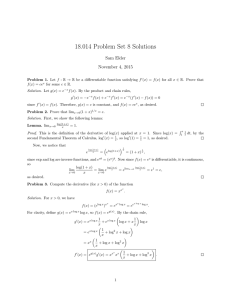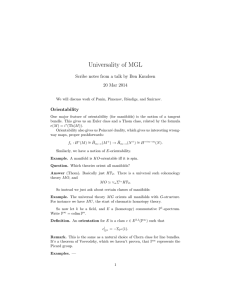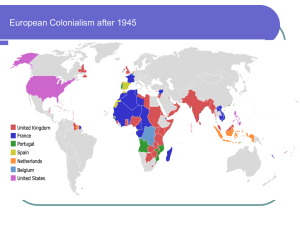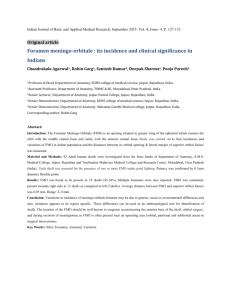Partitioned Tensor Products and Their Spectra
advertisement
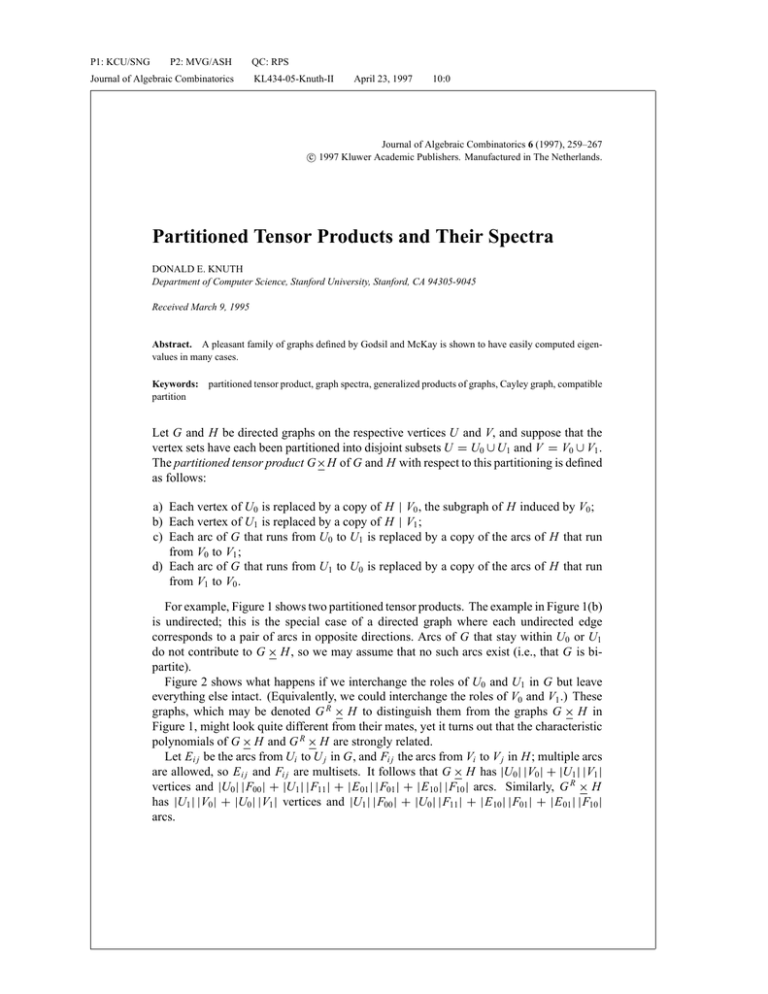
P1: KCU/SNG P2: MVG/ASH Journal of Algebraic Combinatorics QC: RPS KL434-05-Knuth-II April 23, 1997 10:0 Journal of Algebraic Combinatorics 6 (1997), 259–267 c 1997 Kluwer Academic Publishers. Manufactured in The Netherlands. ° Partitioned Tensor Products and Their Spectra DONALD E. KNUTH Department of Computer Science, Stanford University, Stanford, CA 94305-9045 Received March 9, 1995 Abstract. A pleasant family of graphs defined by Godsil and McKay is shown to have easily computed eigenvalues in many cases. Keywords: partitioned tensor product, graph spectra, generalized products of graphs, Cayley graph, compatible partition Let G and H be directed graphs on the respective vertices U and V, and suppose that the vertex sets have each been partitioned into disjoint subsets U = U0 ∪ U1 and V = V0 ∪ V1 . The partitioned tensor product G×H of G and H with respect to this partitioning is defined as follows: a) Each vertex of U0 is replaced by a copy of H | V0 , the subgraph of H induced by V0 ; b) Each vertex of U1 is replaced by a copy of H | V1 ; c) Each arc of G that runs from U0 to U1 is replaced by a copy of the arcs of H that run from V0 to V1 ; d) Each arc of G that runs from U1 to U0 is replaced by a copy of the arcs of H that run from V1 to V0 . For example, Figure 1 shows two partitioned tensor products. The example in Figure 1(b) is undirected; this is the special case of a directed graph where each undirected edge corresponds to a pair of arcs in opposite directions. Arcs of G that stay within U0 or U1 do not contribute to G × H , so we may assume that no such arcs exist (i.e., that G is bipartite). Figure 2 shows what happens if we interchange the roles of U0 and U1 in G but leave everything else intact. (Equivalently, we could interchange the roles of V0 and V1 .) These graphs, which may be denoted G R × H to distinguish them from the graphs G × H in Figure 1, might look quite different from their mates, yet it turns out that the characteristic polynomials of G × H and G R × H are strongly related. Let E i j be the arcs from Ui to U j in G, and Fi j the arcs from Vi to V j in H ; multiple arcs are allowed, so E i j and Fi j are multisets. It follows that G × H has |U0 | |V0 | + |U1 | |V1 | vertices and |U0 | |F00 | + |U1 | |F11 | + |E 01 | |F01 | + |E 10 | |F10 | arcs. Similarly, G R × H has |U1 | |V0 | + |U0 | |V1 | vertices and |U1 | |F00 | + |U0 | |F11 | + |E 10 | |F01 | + |E 01 | |F10 | arcs. P1: KCU/SNG P2: MVG/ASH Journal of Algebraic Combinatorics QC: RPS KL434-05-Knuth-II April 23, 1997 260 10:0 KNUTH Figure 1. Partitioned tensor products, directed and undirected. Figure 2. Dual products after right-left reflection of G. P1: KCU/SNG P2: MVG/ASH QC: RPS Journal of Algebraic Combinatorics KL434-05-Knuth-II April 23, 1997 10:0 261 PARTITIONED TENSOR PRODUCTS AND THEIR SPECTRA The definition of partitioned tensor product is due to Godsil and McKay [3], who proved the remarkable fact that p(G × H ) p(H | V0 )|U1 |−|U0 | = p(G T × H ) p(H | V1 )|U1 |−|U0 | , where p denotes the characteristic polynomial of a graph. They also observed [4] that Figures 1(b) and 2(b) represent the smallest pair of connected undirected graphs having the same spectrum (the same p). The purpose of the present note is to refine their results by showing how to calculate p(G × H ) explicitly in terms of G and H . We can use the symbols G and H to stand for the adjacency matrices as well as for the graphs themselves. Thus we have µ G= G 01 G 11 G 00 G 10 ¶ µ and H= H00 H10 H01 H11 ¶ in partitioned form, where G i j and Hi j denote the respective adjacency matrices corresponding to the arcs E i j and Fi j . (These submatrices are not necessarily square; G i j has size |Ui | × |U j | and Hi j has size |Vi | × |V j |.) It follows by definition that µ G×H = I|U0 | ⊗ H00 G 10 ⊗ H10 G 01 ⊗ H01 I|U1 | ⊗ H11 ¶ where ⊗ denotes the Kronecker product or tensor product [7, page 8] and Ik denotes an identity matrix of size k × k. Let H ↑ σ denote the graph obtained from H by σ -fold repetition of each arc that joins V0 to V1 . In matrix form µ H00 H ↑σ = σ H10 ¶ σ H01 . H11 This definition applies to the adjacency matrix when σ is any complex number, but of course H ↑ σ is difficult to “draw” unless σ is a nonnegative integer. We will show that the characteristic polynomial of G × H factors into characteristic polynomials of graphs H ↑ σ , times a power of the characteristic polynomials of H00 or H11 . The proof is simplest when G is undirected. Theorem 1 Let G be an undirected graph, and let (σ1 , . . . , σl ) be the singular values of T G 01 = G 10 , where l = min(|U0 |, |U1 |). Then ( ¡ Ql p(G × H ) = j=1 ¡ Ql j=1 ¢ p(H ↑ σ j ) p(H00 )|U0 |−|U1 | , ¢ p(H ↑ σ j ) p(H11 )|U1 |−|U0 | , if |U0 | ≥ |U1 |; if |U1 | ≥ |U0 |. Proof: Any real m × n matrix A has a singular value decomposition A = Q S RT P1: KCU/SNG P2: MVG/ASH QC: RPS Journal of Algebraic Combinatorics KL434-05-Knuth-II April 23, 1997 10:0 262 KNUTH where Q is an m × m orthogonal matrix, R is an n × n orthogonal matrix, and S is an m × n matrix with S j j = σ j ≥ 0 for 1 ≤ j ≤ min(m, n) and Si j = 0 for i 6= j [6, page 16]. The numbers σ1 , . . . , σmin(m,n) are called the singular values of A. Let m = |U0 | and n = |U1 |, and suppose that Q S R T is the singular value decomposition of G 01 . Then (σ1 , . . . , σl ) are the nonnegative eigenvalues of the bipartite graph G, and we have µ T µ ¶ ¶ µ ¶ Q ⊗ I|V0 | O O S ⊗ H01 Q ⊗ I|V0 | I|U0 | ⊗ H00 H G × = O R T ⊗ I|V1 | O R ⊗ I|V1 | S T ⊗ H10 I|U1 | ⊗ H11 because G 10 = R S T Q T . Row and column permutations of this matrix transform it into the block diagonal form H ↑ σ1 .. . , H ↑ σl D where D consists of m − n copies of H00 if m ≥ n, or n − m copies of H11 if n ≥ m. 2 A similar result holds when G is directed, but we cannot use the singular value decomposition because the eigenvalues of G might not be real and the elementary divisors of λI − G might not be linear. The following lemma can be used in place of the singular value decomposition in such cases. Lemma Let A and B be arbitrary matrices of complex numbers, where A is m × n and B is n × m. Then we can write A = Q S R −1 , B = RTQ−1 , where Q is a nonsingular m × m matrix, R is a nonsingular n × n matrix, S is an m × n matrix, T is an n × m matrix, and the matrices (S, T ) are triangular with consistent diagonals: Si j = Ti j = 0 S j j = T j j or for i > j; S j j Tj j = 0 for 1 ≤ j ≤ min(m, n). Proof: We may assume that m ≤ n. If AB has a nonzero eigenvalue λ, let σ be any square root of λ and let x be a nonzero m-vector such that ABx = σ 2 x. Then the n-vector y = Bx/σ is nonzero, and we have Ay = σ x , Bx = σ y. On the other hand, if all eigenvalues of AB are zero, let x be a nonzero vector such that ABx = 0. Then if Bx 6= 0, let y = Bx. If Bx = 0, let y be any nonzero vector such that P1: KCU/SNG P2: MVG/ASH QC: RPS Journal of Algebraic Combinatorics KL434-05-Knuth-II April 23, 1997 10:0 263 PARTITIONED TENSOR PRODUCTS AND THEIR SPECTRA Ay = 0; this is possible unless all n columns of A are linearly independent, in which case we must have m = n and we can find y such that Ay = x. In all cases we have therefore demonstrated the existence of nonzero vectors x and y such that Ay = σ x , Bx = τ y , σ =τ or σ τ = 0 . Let X be a nonsingular m × m matrix whose first column is x, and let Y be a nonsingular n × n matrix whose first column is y. Then X −1 AY = µ σ 0 ¶ a , A1 Y −1 B X = µ τ 0 b B1 ¶ where A1 is (m − 1) × (n − 1) and B1 is (n − 1) × (m − 1). If m = 1, let Q = X , R = Y , S = (σ a), and T = ( τ0 ). Otherwise we have A1 = Q 1 S1 R1−1 and B1 = R1 T1 Q −1 1 by induction, and we can let µ 1 Q=X 0 ¶ 0 , Q1 µ 1 R=Y 0 ¶ 0 , R1 µ σ S= 0 ¶ a R1 , S1 All conditions are now fulfilled. µ τ T = 0 ¶ B Q1 . T1 2 Theorem 2 Let G be an arbitrary graph, and let (σ1 , . . . , σl ) be such that σ j = S j j = T j j or σ j = 0 = S j j T j j when G 01 = Q S R −1 and G 10 = RT Q −1 as in the lemma, where l = min(|U0 | , |U1 |). Then p(G × H ) satisfies the identities of Theorem 1. Proof: Proceeding as in the proof of Theorem 1, we have µ ¶ ¶ µ ¶ µ −1 Q ⊗ I|V0 | O O I|U0 | ⊗ H00 S ⊗ H01 Q ⊗ I|V0 | G×H = . T ⊗ H10 I|U1 | ⊗ H11 O R −1 ⊗ I|V1 | O R ⊗ I|V1 | This time a row and column permutation converts the right-hand matrix to a block triangular form, with zeroes below the diagonal blocks. Each block on the diagonal is either H ↑ σ j or H00 or H11 , or of the form µ H00 τ H10 ¶ σ H01 , H11 σ τ = 0. In the latter case the characteristic polynomial is clearly p(H00 ) p(H11 ) = p(H ↑ 0), so the remainder of the proof of Theorem 1 carries over in general. 2 The proof of the lemma shows that the numbers σ12 , . . . , σ p2 are the characteristic roots of G 01 G 10 , when |U0 | ≤ |U1 |, otherwise they are the characteristic roots of G 10 G 01 . Either square root of σ j2 can be chosen, since the matrix H ↑ σ is similar to H ↑ (−σ ). We have now reduced the problem of computing p(G × H ) to the problem of computing the characteristic polynomial of the graphs H ↑ σ . The latter is easy when σ = 0, and P1: KCU/SNG P2: MVG/ASH Journal of Algebraic Combinatorics QC: RPS KL434-05-Knuth-II April 23, 1997 10:0 264 KNUTH some graphs G have only a few nonzero singular values. For example, if G is the complete bipartite √ graph having parts U0 and U1 of sizes m and n, all singular values vanish except for σ = mn. If H is small, and if only a few nonzero σ need to be considered, the computation of p(H ↑ σ ) can be carried out directly. For example, it turns out that λ −1 −σ 0 0 −1 λ 0 0 −σ −σ 0 λ −1 0 0 0 −1 λ −1 0 −σ ¡ 3 ¢ 2 2 2 2 0 = (λ + λ − σ ) λ − λ − (2 + σ )λ + 2 ; −1 λ so we can compute the spectrum of G × H by solving a few quadratic and cubic equations, when H is this particular 5-vertex graph (a partitioned 5-cycle). But it is interesting to look for large families of graphs for which simple formulas yield p(H ↑ σ ) as a function of σ . One such family consists of graphs that have only one edge crossing the partition. Let H00 and H11 be graphs on V0 and V1 , and form the graph H = H00 •−• H11 by adding a single edge between designated vertices x 0 ∈ V0 and x1 ∈ V1 . Then a glance at the adjacency matrix of H shows that p(H ↑ σ ) = p(H00 ) p(H11 ) − σ 2 p(H00 | V0 \x0 ) p(H11 | V1 \x1 ) . (The special case σ = 1 of this formula is Theorem 4.2(ii) of [5].) Another case where p(H ↑ σ ) has a simple form arises when the matrices µ H0 = H00 0 0 H11 µ ¶ and H1 = 0 H10 H01 0 ¶ commute with each other. Then it is well known [2] that the eigenvalues of H0 + σ H1 are λ j + σ µ j , for some ordering of the eigenvalues λ j of H0 and µ j of H1 . Let us say that (V0 , V1 ) is a compatible partition of H if H0 H1 = H1 H0 , i.e., if H00 H01 = H01 H11 and H11 H10 = H10 H00 . T T T When H is undirected, so that H00 = H00 and H11 = H11 and H10 = H01 , the compatibility condition boils down to the single relation H00 H01 = H01 H11 . (∗) Let m = |V0 | and n = |V1 |, so that H00 is m × m, H01 is m × n, and H11 is n × n. One obvious way to satisfy (∗) is to let H00 and H11 both be zero, so that H is bipartite as well as G. Then H ↑ σ is simply σH , the σ -fold repetition of the arcs of H , and its eigenvalues are just those of H multiplied by σ . For example, if G is the M-cube P2M and H is a path PN on N points, and if U0 consists of the vertices of even parity in G while V0 is one P1: KCU/SNG P2: MVG/ASH Journal of Algebraic Combinatorics QC: RPS KL434-05-Knuth-II April 23, 1997 10:0 PARTITIONED TENSOR PRODUCTS AND THEIR SPECTRA Figure 3. 265 P23 × P3 . of H ’s bipartite parts, the characteristic polynomial of G × H is Y µ 1≤ j≤M 1≤k≤N ¶( Mj )/2 kπ , λ − (2N − 4 j) cos N +1 because of the well-known eigenvalues of G and H [1]. Figure 3 illustrates this construction in the special case M = N = 3. The smallest pair of cospectral graphs, and , is obtained in a similar way by considering the eigenvalues of P3 × P3 and P3T × P3 [4]. Another simple way to satisfy the compatibility condition (∗) with symmetric matrices H00 and H11 is to let H01 consist entirely of 1s, and to let H00 and H11 both be regular graphs of the same degree d. Then the eigenvalues of H0 are (λ1 , . . . , λm , λ01 , . . . , λ0n ), where (λ1 , . . . , λm ) belong to√H00 and√(λ02 , . . . , λ0n ) belong to H11 and λ1 = λ01 = d. The eigenvalues of H1 are ( mn, − mn, 0, . . . , 0). We can match the eigenvalues of H0 properly with those of H1 by looking at the common√eigenvectors (1, . . . , 1)T and (1, . . . , 1, −1, . . . , −1)T that correspond to d in H0 and ± mn in H1 ; the eigenvalues of H ↑ σ are therefore √ √ (d + σ mn, λ2 , . . . , λm , d − σ mn, λ02 , . . . , λ0n ) . Yet another easy way to satisfy (∗) is to assume that m = n and to let H00 = H11 commute with H01 . One general construction of this kind arises when the vertices of V0 and V1 are the elements of a group, and when H00 = H11 is a Cayley graph on that group. In other words, two elements α and β are adjacent in H00 iff αβ −1 ∈ X , where X is an arbitrary set of group elements closed under inverses. And we can let α ∈ V0 be adjacent to β ∈ V1 iff αβ −1 ∈ Y , where Y is any normal subgroup. Then H00 commutes with H01 . The effect is to make the cosets of Y fully interconnected between V0 and V1 , while retaining a more interesting Cayley graph structure inside V0 and V1 . If Y is the trivial subgroup, so that H01 is simply the identity matrix, our partitioned tensor product G × H becomes simply the ordinary Cartesian product G ⊕ H = I|U | ⊗ H + G ⊗ I|V | . But in many other cases this construction gives something more general. P1: KCU/SNG P2: MVG/ASH Journal of Algebraic Combinatorics QC: RPS KL434-05-Knuth-II April 23, 1997 10:0 266 KNUTH A fourth family of compatible partitions is illustrated by the following graph H in which m = 6 and n = 12: 0 0 1 1 1 0 1 0 0 0 0 0 0 1 0 0 0 0 0 0 0 1 1 1 0 1 0 0 0 0 0 0 1 0 0 0 1 0 0 0 1 1 0 0 1 0 0 0 0 0 0 1 0 0 1 1 0 0 0 1 0 0 0 1 0 0 0 0 0 0 1 0 1 1 1 0 0 0 0 0 0 0 1 0 0 0 0 0 0 1 0 1 1 1 0 0 0 0 0 0 0 1 1 0 0 0 0 0 1 0 0 0 0 0 0 0 1 0 1 0 0 0 0 0 1 0 0 1 0 0 0 0 0 0 0 1 0 1 0 0 0 0 0 1 0 0 1 0 0 0 1 0 0 0 1 0 1 0 0 0 0 0 0 0 0 1 0 0 0 1 0 0 0 1 0 1 0 0 0 0 0 0 0 0 1 0 1 0 1 0 0 0 0 0 1 0 0 0 0 0 0 0 0 1 0 1 0 1 0 0 0 0 0 1 0 0 0 0 0 0 0 1 0 0 1 0 0 0 0 0 1 0 1 0 1 0 0 0 0 0 0 0 0 1 0 0 0 0 0 1 0 1 0 1 0 0 0 0 0 0 0 0 1 0 1 0 0 0 1 0 0 0 1 0 0 0 0 0 0 0 0 1 0 1 0 0 0 1 0 0 0 1 0 0 1 0 0 0 0 0 1 0 1 0 0 0 0 0 0 0 1 0 0 1 0 0 0 0 0 1 0 1 0 0 In general, let C2k be the matrix of a cyclic permutation on 2k elements, and let m = 2k, n = 4k. Then we obtain a compatible partition if H00 ¡ j −j¢ k = C2k + C2k + C2k , H01 = (I2k C2k ) , H11 = Ã j −j C2k + C2k k−1 C2k k+1 C2k j ! −j C2k + C2k . The 18 × 18 example matrix is the special case j = 2, k = 3. The eigenvalues of H ↑ σ in general are ω jl + ω− jl + 1, ω jl + ω− jl − 1 + √ 2 σ, ω jl + ω− jl − 1 − √ 2σ for 0 ≤ l < 2k, where ω = eπi/k . Compatible partitionings of digraphs are not difficult to construct. But it would be interesting to find further examples of undirected graphs, without multiple edges, that have a compatible partition. References 1. Dragoš M. Cvetković, Michael Doob, and Horst Sachs, Spectra of Graphs, Academic Press, New York, 1980. 2. G. Frobenius, “Über vertauschbare Matrizen,” Sitzungsberichte der Königlich Preußischen Akademie der Wissenschaften zu Berlin, 1896, pp. 601–614. Reprinted in his Gesammelte Abhandlungen, Springer, Berlin, 1968, Vol. 2, pp. 705–718. P1: KCU/SNG P2: MVG/ASH Journal of Algebraic Combinatorics QC: RPS KL434-05-Knuth-II April 23, 1997 10:0 PARTITIONED TENSOR PRODUCTS AND THEIR SPECTRA 267 3. C. Godsil and B. McKay, “Products of graphs and their spectra,” in Combinatorial Mathematics IV, A. Dold and B. Eckmann (Eds.), Lecture Notes in Mathematics, Vol. 560, pp. 61–72, 1975. 4. C. Godsil and B. McKay, “Some computational results on the spectra of graphs,” in Combinatorial Mathematics IV, A. Dold and B. Eckmann (Eds.), Lecture Notes in Mathematics, Vol. 560, pp. 73–82, 1975. 5. C.D. Godsil and B.D. McKay, “Constructing cospectral graphs,” Æquationes Mathematicæ 25 (1982), 257– 268. 6. Gene H. Golub and Charles F. Van Loan, Matrix Computations, Johns Hopkins University Press, Baltimore, 1983. 7. Marvin Marcus and Henrik Minc, A Survey of Matrix Theory and Matrix Inequalities, Allyn and Bacon, Boston, 1964.


